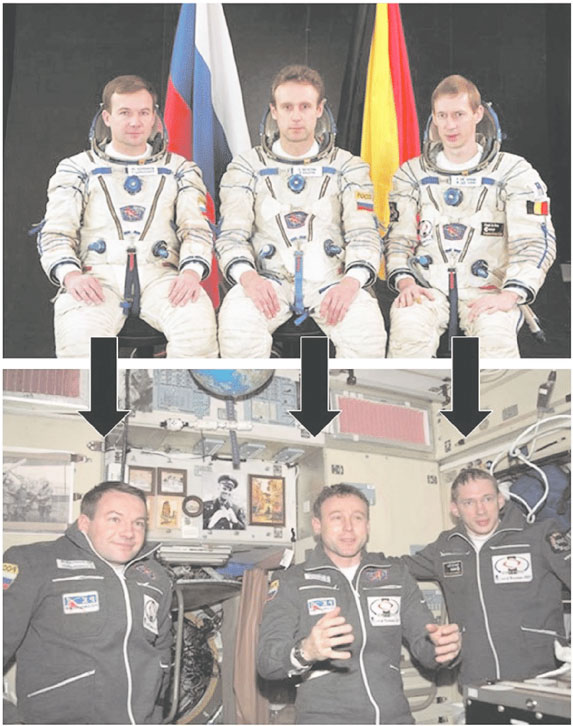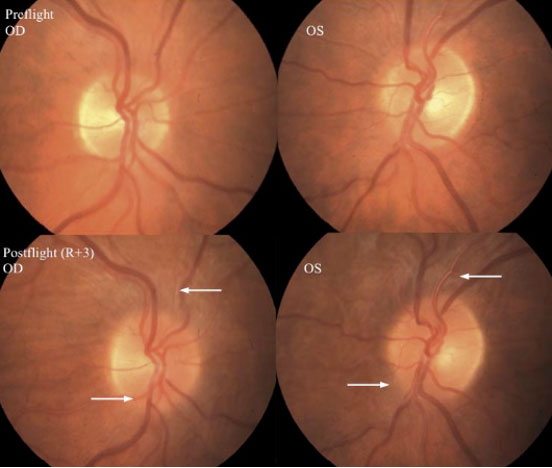An Eye on Long-Term Space Flight
By Shannon Persaud
Microgravity causes fluid shifts in the body that can affect vision.
May 14, 2024
From The Staff Anthropology Astronomy Astronautics Astrophysics
Humans have been exploring space for the past century, yet the farthest astronauts have ventured is the Moon. With the possibility of a crewed mission to Mars in the coming decade, NASA has made it a priority to understand the significant physiological changes that a two- to three-year journey through space can cause in astronauts' bodies. And one effect that’s at the forefront of such concerns are changes to astronauts’ vision.
Ophthalmologist Andrew G. Lee and his colleagues at Houston Methodist Hospital are delving into a newly classified condition known as Spaceflight Associated Neuro-Ocular Syndrome (SANS), which can manifest during spaceflights lasting six months or more. SANS is part of a broader condition that is colloquially termed “puffy head bird legs,” because prolonged exposure to low gravity causes bodily fluids to move upward. Eventually, this fluid shift leads to facial puffiness and the appearance of thinner legs, with potential consequences for organs such as the eyes because of increased pressure in the upper body.
SANS, specifically characterized by fluid accumulation in the eye socket, alters the eye's shape, causes swelling and increased pressure, and may eventually lead to vision difficulties after astronauts return to Earth. But while astronauts are in space, they may only notice subtle vision changes, making the condition challenging to diagnose.

Photograph courtesy of the European Space Agency
Astronauts aboard the International Space Station (ISS) uses ultrasound and other medical scanning devices to image the eyes and measure visual acuity. However, magnetic resonance imaging (MRI), identified as the most effective diagnostic tool for SANS, is impractical in space because of size constraints, so scans have to wait until astronauts are back on Earth.
Studying SANS is further complicated because there’s a very small group of affected people. “Since the Earth does not experience microgravity, the sample size for SANS testing is limited to astronauts, making research difficult,” Lee says. So the researchers replicate the conditions of long-duration spaceflights on Earth, using what are called head-down tilt studies, placing patients upside down for a short time. “These studies mimic the fluid shift seen in space," Lee says, "and provide the closest symptoms to SANS while avoiding the need for a long-duration spaceflight.”
The goal of the research is to comprehensively understand the disease's severity, its correlation with duration under these conditions, and strategies for prevention. Lee and his colleagues have two main theories of the causes of SANS: intraorbital or intracranial pressure. Although both conditions involve increased pressure, Lee leans towards intraorbital pressure as the primary culprit.
In a February 2024 paper in the journal Eye, Lee and his colleagues report that their head-down tilt studies have found similar results to what astronauts experience, in that intraorbital pressure spikes when an astronaut first enters microgravity, then normalizes over a few days. However, in space, fluid is still shifting toward the head, indicating that the eye may be compensating by maintaining a lower volume. By imaging glaucoma patients on Earth, Lee and his colleagues report that the drainage system in the eye may be physically altered by increased intraorbital pressure, increasing outflow. Lee and his colleagues plan to next image head-down tilt study participants to see if the same effect occurs for them, and if treatments to reduce outflow could help maintain proper eye volume.

Photograph courtesy of NASA Risk of Spaceflight Associated Neuro-ocular Syndrome Evidence Report
The ISS already has tools, such as what is called a Lower Body Negative Pressure (LBNP) device, to counteract the effects of microgravity. On Earth, this device has successfully reversed fluid shifts in head-down tilt studies, so it could be a potential solution for long space missions. Another potential countermeasure is medication that can reduce overall body fluid levels.
“As physicians, we always seek more data, but time in space is precious and managed meticulously,” says Lee. “With technological advancements, the prospect of deploying more machines alongside astronauts becomes increasingly promising, offering valuable insights into mitigating the effects of microgravity on the human body.”
American Scientist Comments and Discussion
To discuss our articles or comment on them, please share them and tag American Scientist on social media platforms. Here are links to our profiles on Twitter, Facebook, and LinkedIn.
If we re-share your post, we will moderate comments/discussion following our comments policy.